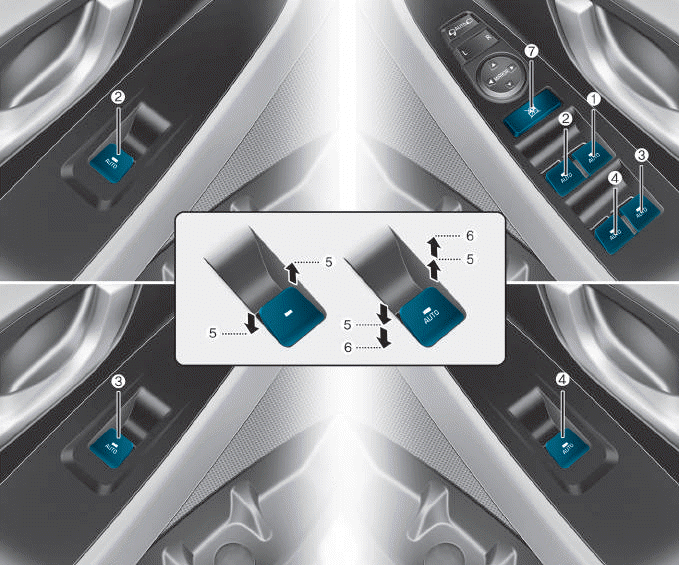Hyundai i-30: Child restraint system (CRS) / Selecting a Child Restraint System (CRS)
When selecting a Child Restraint System for your child, always:
- Make sure the Child Restraint System has a label certifying that it meets applicable Safety Standards of your country. A Child Restraint System may only be installed if it was approved in accordance with the requirements of ECE-R44 or ECE-R129.
- Select a Child Restraint System based on your child’s height and weight. The required label or the instructions for use typically provide this information.
- Select a Child Restraint System that fits the vehicle seating position where it will be used.
- Read and comply with the warnings and instructions for installation and use provided with the Child Restraint System.
Child Restraint System types
There are three main types of Child Restraint Systems: rearward-facing, forward-facing and booster Child Restraint Systems.
They are classified according to the child’s age, height and weight.
Rearward-facing Child Restraint System

A rearward-facing Child Restraint System provides restraint with the seating surface against the back of the child. The harness system holds the child in place, and in an accident, acts to keep the child positioned in the Child Restraint Systems and reduce the stress to the fragile neck and spinal cord.
All children under the age of one year must always ride in a rearward-facing Child Restraint System. There are different types of rearward-facing Child Restraint Systems: infant-only Child Restraint Systems can only be used rearward-facing. Convertible and 3-in- 1 Child Restraint Systems typically have higher height and weight limits for the rearward-facing position, allowing you to keep your child rearwardfacing for a longer period of time.
Keep using Child Restraint Systems in the rearward-facing position as long as children fit within the height and weight limits allowed by the Child Restraint System's manufacturer.
Forward-facing Child Restraint System

A forward-facing Child Restraint System provides restraint for the child’s body with a harness. Keep children in a forward- facing Child Restraint System with a harness until they reach the top height or weight limit allowed by your Child Restraint System’s manufacturer.
Once your child outgrows the forwardfacing Child Restraint System, your child is ready for a booster seat.
Booster seats
A booster seat is a Child Restraint System designed to improve the fit of the vehicle’s seat belt system. A booster seat positions the seat belt so that it fits properly over the stronger parts of your child’s body.Keep your children in booster seats until they are big enough to fit in a seat belt properly.
For a seat belt to fit properly, the lap belt must lie comfortable across the upper thighs, not the stomach. The shoulder belt should lie comfortable across the shoulder and chest and not across the neck or face. Children under age 13 must always be properly restrained to minimise the risk of injury in an accident, sudden stop or sudden manoeuvre.
 Child restraint system (CRS)
Child restraint system (CRS)
Our recommendation:
Children always in the rear
WARNING
Always properly restrain children
in the vehicle. Children of all ages
are safer when riding in the rear
seats...
 Installing a Child Restraint
System (CRS)
Installing a Child Restraint
System (CRS)
WARNING
Before installing your Child
Restraint System always:
Read and follow the instructions
provided by the manufacturer of
the Child Restraint System...
Other information:
Hyundai i30 (PD) 2018-2025 Service Manual: Panorama Sunroof Movable Glass Tilt Lever
Repair procedures Replacement 1. Remove the movable glass. (Panorama sunroof - refer "movable glass") 2. Remove the tilt lever (A) loosening mounting screws using star wrench (T20)...
Hyundai i30 (PD) 2018-2025 Owner's Manual: Front seat head restraints
The driver’s and front passenger’s seats are equipped with adjustable head restraints for the passengers safety and comfort. Adjusting the height up and down To raise the head restraint: 1. Pull it up to the desired position (1). To lower the head restraint: 1...
Categories
- Manuals Home
- 3rd Generation i30 Owners Manual
- 3rd Generation i30 Service Manual
- Tyre pressure monitoring system
- Auto door lock/unlock features
- Battery replacement
- New on site
- Most important about car
Power windows

(1) Driver’s door power window
switch
(2) Front passenger’s door power
window switch
(3) Rear door (right) power window
switch
(4) Rear door (left) power window
switch
(5) Window opening and closing
(6) Automatic power window
(7) Power window lock switch
